9+ SAMPLE Nonprofit Partnership Proposal
-
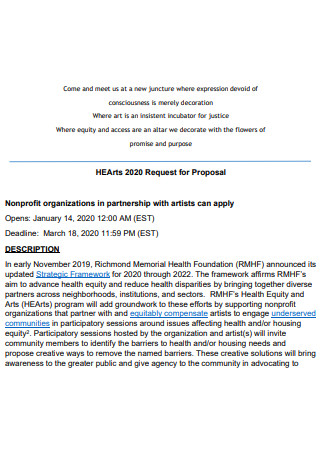
Non-Profit Partnership Proposal
download now -
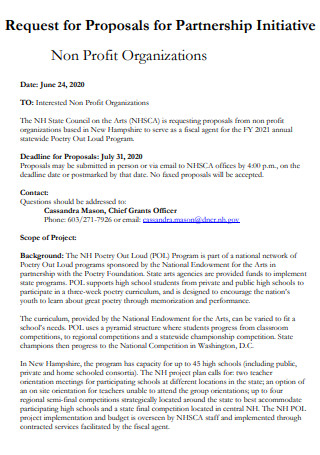
Non-Profit Partnership Grant Proposal
download now -

Private Non-Profit Partnership Proposal
download now -
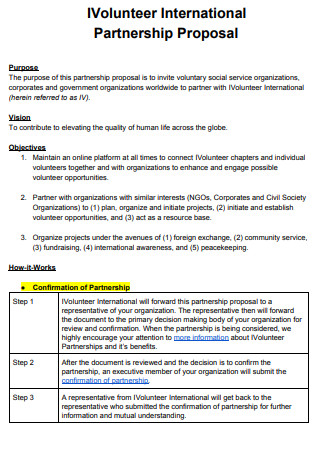
Non-Profit Volunteer Partnership Proposal
download now -
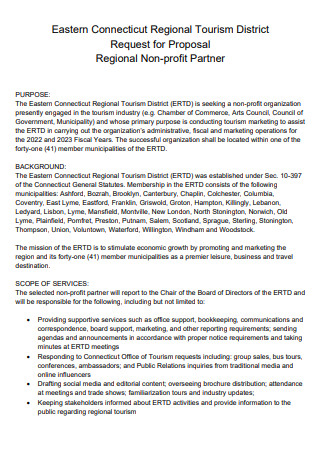
Non-Profit Partnership Request for Proposal
download now -
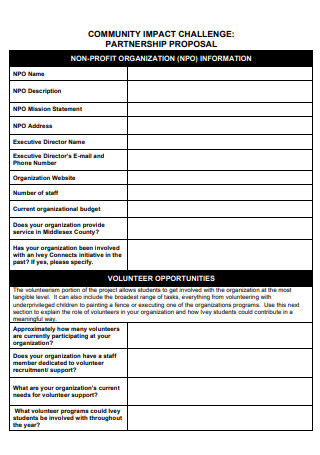
Non-Profit Organization Partnership Proposal
download now -
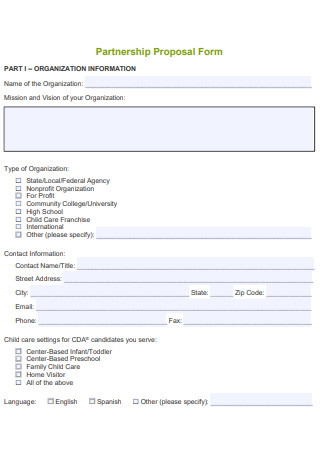
Non-Profit Partnership Proposal Form
download now -
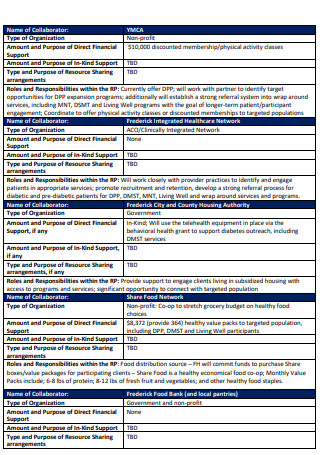
Non-Profit Partnership Grant Program Proposal
download now -
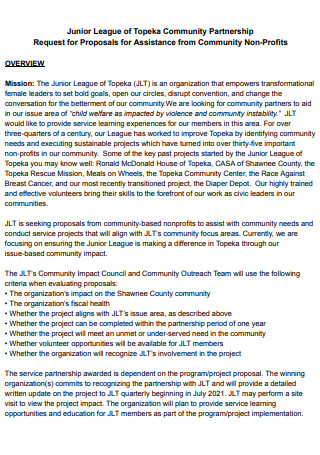
Community Non-Profit Partnership Proposal
download now -

Non-Profit Partnership Agency Proposal
download now
FREE Nonprofit Partnership Proposal s to Download
9+ SAMPLE Nonprofit Partnership Proposal
What Is a Nonprofit Partnership Proposal?
The Different Faces of Nonprofit Organizations
The Essentials of a Nonprofit Partnership Proposal
What is the structure of a nonprofit organization?
What are some of the nonprofit fundraising strategies?
What are some of the advocacies of nonprofit organizations?
What Is a Nonprofit Partnership Proposal?
A nonprofit partnership proposal is a document that approaches a suggestion to a partnership between a nonprofit and a corporate entity, a for-profit organization, and even another nonprofit entity. The document outlines what are the benefits that would be gained out of the partnership, the similarities and shared mission, vision, culture, and values between the two, the goals and objectives of the partnership, and the nonprofit programs and strategic steps to be taken to accomplish those goals and objectives. Typically, a partnership is entered into by nonprofit organizations to broaden their reach and further their mission’s public awareness and advocacy. Leveraging on the partnered entity’s existing market, nonprofits use their partner’s influence to expand their programs and invite and create multiple stakeholders to join in on their advocacy, enter new territories, and eventually expand the reach of their programs.
The Different Faces of Nonprofit Organizations
You see them all over different media channels. Their advocacies are broad and diverse. You see them fighting for women’s rights, animal welfare, sustainable livelihood, children’s rights, educational rights, environmental protection, and so on. It goes to show how powerful the messages nonprofit organizations put out there for people to listen to and to take action. They are modern-day superheroes, often working under the shadow and out of the limelight. Their core mission and values are what bring them together, to be able to think of ways, and sometimes even thinking out-of-the-box, to be able to bring that help and solution to those who needed it the most, that oftentimes got overlooked by the society at large. What are these faces that the nonprofit organization represents? What are the common types of nonprofits and what makes them different from one another?
The Essentials of a Nonprofit Partnership Proposal
One of the best ways for nonprofits to thrive is to form partnerships. Collaborating with corporations, organizations, or other nonprofit groups opens up a ton of opportunities for nonprofits to expand and succeed in their missionary works. Especially if the partnered company is a well-known company, the nonprofit can be able to use the company’s influence to help spread the nonprofit’s advocacy and generate more support, most especially funding, for their campaigns. Before a partnership even begins, nonprofits have to do diligent research on who is the best partner to connect with in the first place. They need to lay out what are the goals of the partnership, as well as the benefits that will be gained from the collaboration. A nonprofit partnership proposal should be prepared at the onset of the idea of creating an alliance. Here are the essential elements that need to be included in creating an effective partnership proposal.
-
Step 1: Writing the Executive Summary
The nonprofit partnership proposal executive summary provides a brief background or an introduction to the nonprofit organization. It provides the reason behind the proposal, as well as an overview of what can be gained out of the partnership. An Executive Summary often includes a mission and a vision statement. A Mission Statement explains the purpose of the proposed partnership, and also highlights the culture and values from which the partnership is to be formed from. A Vision Statement is a call to action statement. It gives a depiction of what is hoped to be achieved out of the partnership in a given time. Both the mission and the vision statement aim to inspire and motivate its audience to the core advocacy of the nonprofit.
-
Step 2: Beneficiary Outlook
Before coming up with the proposed action plans, identify first if there is a need for the services that are offered by the nonprofit. Doing a Market Analysis, or a study of the target market, or beneficiaries, in this case, should be made as part of the research. A market analysis helps identify and categorize the needs of targeted beneficiaries according to demographics such as age, gender, income, lifestyle, livelihood, location, et cetera. The action plans are then formed based on this demographic classification.
-
Step 3: Partnership Programs and Agenda
This is the part where you lay out the action plans or the programs and agendas you have in mind for the partnership. The partnership could be in the form of full collaboration, or even in the form of Sponsorship Agreement type. For instance, nonprofit A is a public charity that offers free feeding programs. Nonprofit A approaches Company B, a well-known fast-food restaurant in the area, and proposes a partnership that Company B will provide the food supply for one of Nonprofit A’s feeding programs. In turn, Nonprofit A will be helping out in the marketing campaigns of Company B by including the name of Company B in its advertisements. As a form of full collaboration, Nonprofit A provides the venue and does the rest of the campaigning and promoting the feeding program, while Company B provides the food and the manpower to assist during the run of the program. In a sponsorship type of partnership, it can be in the form of Company B providing the funds needed to run the feeding program, but not necessarily working hand in hand in the planning and execution of the program.
-
Step 4: Partnership Benefits
Partnerships are formed mainly due to the benefits that they can gain from the partnership. Despite having a charitable purpose and mission, getting corporations, organizations, or even other nonprofits to agree to ally would not be possible without learning what they would stand to gain from such a relationship. One of the biggest benefits that would stem out of a partnership is exposure. Partnering with a business that has an established large customer market will benefit the nonprofit the most by pulling the nonprofit into the limelight along with the business. The public awareness for the nonprofit’s mission gets bigger coverage, as well as potentially increasing the support and funding for the nonprofit’s undertakings. Another benefit that could be gained from the partnership is enhancing the credibility of both partners. For instance, a restaurant partnering with a public charity that’s advocating for children’s and women’s rights is good marketing publicity for the restaurant. People trust businesses who are involved in social advocacy work, thereby potentially increasing customer loyalty and acquiring new customers as well for the business. In the same sense, people trust nonprofits who work closely with big corporate names, or businesses with an established good reputation.
-
Step 5: Terms of Agreement
The terms of the agreement provide the roles and responsibilities of each of the parties involved in the partnership. The terms of the agreement provide safeguards in the relationship between the parties. It includes the division of duties, contributions, duration of partnership, decision-making and dispute process, withdrawal, cancellation, or termination provisions, as well as the details on the sharing of assets and liabilities.
FAQs
What is the structure of a nonprofit organization?
A nonprofit’s structure is just as similar to any other type of organization. It has its organizational chart and is run by people who manage both the administrative and operational aspects of the nonprofit. A nonprofit organization has three areas: governance, administration, and programs. The governance part is made up of the board directors, the decision-makers of the nonprofit. They are the ones deciding and approving the programs and activities, making financial decisions, as well as planning the promotional and campaigning part of the nonprofit. The administration section is those that support the functions of the governing board. They do the administration and clerical tasks, as well as making the reports and presentations. The program section is tasked with the implementation of the nonprofit’s programs and activities. They are made up of volunteers, organizers, marketers, fundraisers, et cetera.
What are some of the nonprofit fundraising strategies?
Nonprofits depend entirely on contributions, donations, solicitations, and even grants coming from individuals or organizations. To come up with the funds, nonprofits have to create fundraising plan activities to support their works and to raise and draw public awareness to their cause and mission at the same time. One of the popular fundraising strategies is crowdfunding. Crowdfunding is done by engaging the population at large to donate money to a specified cause. Applying the power of incrementing value, no matter how little or how large a sum of money was donated, add it up to the other donations, the result is still a big sum of donation. Another fundraising strategy is peer-to-peer fundraising. This type of strategy is any locally organized event wherein it encourages participation from the community. A common example is a community marathon event. The income from the event comes from the registration fee paid by participants, and the prizes came from business sponsorships. Direct mail and online donations are the other two fundraising strategies. Direct mail is an old-school type of fundraising, where letters are being sent out, and individuals who wish to donate would send in their details on how they will be charged for the donation, or even sometimes send cash and cheques back through the mail. Online donation is a type of strategy that’s taking advantage of the digital world, either through websites or social media platforms. Oftentimes they come in the form of a blog or vlog posts, with a “click this” link that will lead them onto a different page where they can make their donations.
What are some of the advocacies of nonprofit organizations?
Nonprofits are formed first and foremost out of a core passion or advocacy, that’s why nonprofit groups come in all sorts of shapes and sizes. Some of the most common advocacies held by nonprofits are poverty, hunger, homelessness, health care, education, social services, arts, civil rights, environment, immigration, church and religion, animal welfare, and so on.
Nonprofits partnering up with other organizations or entities is a very beneficial move. Not only does it provide the expanded exposure nonprofits need, but it also provides a great potential in increasing public support and awareness of the nonprofit’s advocacy and campaign. Organizations who partnered up with nonprofits also stand to gain from the partnership. And these are all outlined and presented in a nonprofit partnership proposal.
Check out our nonprofit partnership proposal templates. Our proposal templates are ready-drafted and made easy for you to fill out, download, and use for your partnership proposal presentation. Download one now, and see how easy it is to create that proposal that gets a sign-off and a nod of approval from your target partners!
